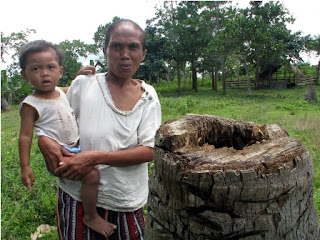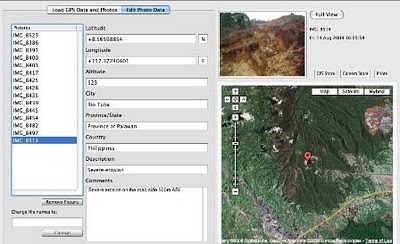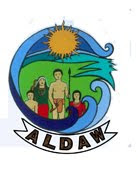Hôtel Novotel de N’Djamena, N’Djamena, Republic of Chad, 7-9 November 2011
Climate change poses one of the greatest challenges to humanity. Global warming and associated climatic changes are impacting on pastoralist peoples with increasing frequency and severity. African indigenous peoples’ delegates at the N’Djamena conference on adaptation noted first-hand experiences of droughts, flooding, dislocation of seasonal cycles, changes in the composition of grazing lands, and changes in accessibility and quality of water.

Indigenous herders from five African countries (Chad, Niger, Kenya, Namibia and South Africa) attended a two-day conference in N’Djamena Chad to share with each other and with meteorologists about how traditional knowledge and climate science can be combined to respond to current threats and risks. The conference also considered the need for effective participation of indigenous peoples, including herders, in national adaptation platforms and other national processes to ensure peace, sustainable livelihoods and biological conservation in the face of worsening climate instability.
Indigenous peoples’ delegates worked with the National Meteorological Services of Chad, the National Centre for Support to Research (
CNAR), as well as international agencies, including the World Meteorological Organisation (
WMO),
UNESCO, the Global Environmental Fund (GEF) –
Small Grants Projects, and the Technical Centre for Agricultural and Rural Cooperation EU-ACP (
CTA). The results of the workshop were shared with the Honourable Minister of Urban and Rural Hydrology, and the Honourable Minister of Agriculture and Irrigation of the Republic of Chad. This declaration constitutes to the key results of the conference and the day of restitution.
Key findings included:
- Traditional knowledge and climate science are both critically important for adaptation policy and supporting resilience building of rural communities necessary to cope with climate change;
- Traditional knowledge and climate science need to be shared to create synergies that can inform adaptation policy, monitoring and assessment. It is through a combination of both knowledge systems that we are likely to achieve better synchronisation between forecasting, anticipatory responses, appropriate governance responses and feed-back. Both knowledge systems need to be converted into media that is understandable and usable in national adaptation platforms and for public use;
- Climate change amplifies social and economic vulnerability, with the risk of serious conflict and poverty. An essential element of climate adaptation is ensuring good governance, human rights and social equity to maintain local, national and regional harmony during times of stress;
- The United Nations’ Cancún Adaptation Framework, the National Adaptation Programmes of Action (NAPAs) and National Adaptation Plans (NAPs) may be best effected through well designed and funded national adaptation platforms;
- National adaptation platforms need to include a diverse range of rural and urban communities, with particular attention to participatory approaches to facilitate the contributions of pastoralists, hunter-gathers, farmers and fisherfolk.
- National adaptation platforms need to facilitate a two-way flow of ideas, information and strategies for resilience building and equitable sharing of costs and benefits. The inputs to and outputs from the platforms need to be meaningful and relevant.
Conference summary
Pastoralism evolved in Africa specifically as an adaptive response to climate and environmental conditions which limited the expansion of agriculture. Pastoralism has co-evolved as diverse cultural and economic systems within ecological niches around Africa. The result has been millennia of managing sheep, camels and cattle in different ecosystems and landscapes throughout long cycles of climatic changes. Pastoralism has always been premised on the need to maintain biodiversity as the underpinning of human and livestock well-being.
Climate change in combination with other drivers of declining biodiversity has reduced the effectiveness of pastoral societies to maintain both social harmony and biological resilience. At the same time, the reduction in agricultural capacity will likely lead to increased reliance on pastoralism and agro-pastoralism for African food security.
The N’Djamena conference and Declaration were elaborated as part of IPACC and AFPAT’s support for the Cancún Adaptation Framework, which was adopted by the 16th Conference of Parties to the United Nations Convention on Climate Change, held in Cancun, Mexico in December 2010. IPACC is a contributor to the UN Framework Convention on Climate Change’s Nairobi Work Programme on impacts, vulnerability and adaptation to climate change (UNFCCC NWP).
IPACC and AFPAT were influenced by the World Meteorological Organisation’s World Climate Conference – 3, held in Geneva, Switzerland in 2009. IPACC and AFPAT have initiated cooperation with both WMO and the African Centre for Meteorological Application for Development (
ACMAD). The CTAis a partner of IPACC, assisting with building technical, information and policy capacity. CTA and the Open Society in Southern Africa (
OSISA) were the principal funders behind the N’Djamena conference. Additional conceptual and policy support has been provided by the Local and Indigenous Knowledge Systems unit of the United Nations’ Educational, Scientific and Cultural Organisation (UNESCO).
The results of climate change include greater vulnerability of ecosystems as well as threatening human social and economic systems. Climate change is impacting negatively on health, livelihoods, peace and security. While the only answer is an urgent, robust and binding global agreement on the reduction of Green House Gas emissions, the reality is that Africa must take urgent steps to adapt to climate instability, reduce vulnerability and build resilience of both natural and human systems.
Despite the very serious risks from climate change, the N’Djamena conference delegates noted that climate change is only one element of the many challenges facing African indigenous pastoralists. Changes in land use and occupancy, different forms of pollution (e.g. radioactive pollution of aquifers), drylands deforestation, the negative impacts of extractive industries and a general decline in biodiversity across Africa are all contributing to growing poverty and vulnerability of indigenous peoples.
The following key issues and recommendations emerged from the consultations.
Knowledge Management
It was agreed by delegates that knowledge management is centrally important to successful adaptation. Traditional Knowledge (TK) / Indigenous Knowledge Systems are valuable resources for monitoring, analysing and responding to climate change. TK has the benefit of including information on biology and ecosystems, while simultaneously locating this in a landscape approach to sustainability. TK exists in cultural systems which contribute to governance, equity, rights and stewardship responsibilities. TK thus combines knowledge with wisdom, values and social obligations. TK is itself an integration of science, skills and a normative framework for sustainable living.
Delegates noted that atmospheric (meteorological and climatic) science has much to offer rural communities including pastoralists. All participants emphasised that atmospheric science is a vitally important knowledge source that needs to be widely available to all scales of decision-makers. Climatological modelling and early warning systems can help pastoralists make informed decisions about carrying capacity, transhumance, nature conservation, water management and risk reduction.
The challenge for both systems of knowledge - traditional and scientific - is how they can be made usable for decision-makers, and how they can be used in synergy with each other to ensure a robust, shared approach to adaptation. Attention and expertise is required to facilitate the intercultural mediation of science and TK, generating understandable and usable research that helps decision-makers at local, national and regional scales.
Delegates called on African States to recognise the value of combining Traditional Knowledge along with atmospheric sciences to achieve synergies in policy making. Both systems of knowledge need to be interpreted to make them useful in adaptation planning and implementation. Delegates recommended facilitating a sustained dialogue between holders of the different knowledge systems, on-going cooperation, and effective integration of both knowledge systems in national, regional and international platforms.
Delegates noted that there is evidence that local varieties of livestock and plants appear more drought-, flood- and disease resistant than hybrid or alien species. Local varieties may have lower yield or commercial value, but their sustainability means that they provide greater security in the medium and long term. They may also be more appropriate to maintaining biodiversity and ecosystem integrity. Delegates recommended that more research funding and technical support should be provided to help protect indigenous species of plants and livestock.

Traditional knowledge does not exist independently of indigenous institutions. Valorising TK also means recognising how indigenous peoples hold, manage and innovate their knowledge systems. Traditional leaders, religious leaders, shaman, herders, oasis dwellers, metal and leather workers, traditional healers, men and women throughout the society are all important in sustaining and transmitting TK. This implies that it is not enough to have a nominal pastoralist presence in policy-making; there must be a productive interaction between State institutions, research institutions and indigenous peoples’ institutions to achieve coherence and sustainability.
New technologies, particularly information communication technology (ICTs) offer us new means by which to involve holders of traditional knowledge and the conversion of local oral knowledge into information and data which are useful for decision making at different scales. More attention needs to be given to these methods of bridging between orality and information than can feed policy processes.
Cybertracker is one example of an African ICT which can assist with linking TK and valuable data required for adaptation planning and monitoring.
Delegates noted the valuable work done by the World Meteorological Organisation and African States to make meteorological services available to rural communities. Delegates encouraged State Parties and agencies to continue developing the use of appropriate technologies, such as participatory mapping, radio, and mobile devices and applications, to provide a two-way flow of climate and weather information that connects national meteorological services with rural communities.
Governance and Rights
Climate change amplifies existing social, economic and environmental problems. Part of adaptation policy making requires addressing issues of rights, equity, fiscal integrity and good governance. Continued widespread problems of corruption, discrimination and marginalisation aggravate the risk of conflicts and vulnerability. Climate change places greater pressure on all Africans, those in State agencies and civil society, to ensure compliance with principles of human rights, good governance and inclusion in decision making.

Delegates noted that discrimination against pastoralists finds its roots in colonialism and European legal biases imported into Africa. This is most evident in the problems of land tenure and resource rights of mobile peoples in Africa today. Traditionally, hunters, herders, farmers and fishing peoples had complementary land and natural resource use and tenure systems. There was coherence between rights to resources and the responsibility of communities for stewardship and conservation. This coherence of rights and responsibilities has been damaged and has not been adequately addressed in the post-colonial context. The current marginalisation of indigenous pastoralists can only be resolved by reforms to land rights, land tenure and access to natural resources legislation and practices.
Land tenure and resources rights need to be reviewed in relation to ecosystem capacity and achieving harmonious and equitable coexistence of communities who have different land use requirements. This too is part of building resilience and adapting to climate change.
IPACC members noted the value of the UN Declaration on the Rights of Indigenous Peoples as a new-generation international standard for promoting indigenous peoples’ rights and institutional engagement between State agencies and indigenous peoples.
Delegates noted that nature conservation is essential for subsistence economies. At the same time, exclusion from some Protected Areas has broken up indigenous territories and resulted in increased vulnerability to extreme weather and unstable climate conditions. Delegates invite State Parties to take a fresh look at the role of Protected Areas in providing remedial territories during droughts and flooding to allow pastoralists to lighten their impact on ecosystems. Protected Areas are important for conservation but should be seen within a wider scope of landscape connectivity and conservation, which includes mobile pastoralism.
The governance issue also speaks to proper assessment of equitable costs and benefits. As noted in the UNEP Green Economy Initiative, the value of rural economies and ecosystems needs to be taken into consideration before other economic decisions are made. Gross Domestic Product cannot be the sole determinant for approving new extractive industries and infrastructure projects. Environmental degradation leads to long-term vulnerability and places greater costs on State treasuries by increasing poverty, urban migration, declining food security and health and the collapse of local economies.
Where mines and tourism exist in pastoralist territories, the revenues from these ventures need to be handled transparently with benefits being shared equitably. Extractive industries need to be actively contributing to ecosystem conservation and resilience, and the costs of climate adaptation.
The value of pastoralism needs to be clearly and correctly assessed, and included in national decision making on resource and land allocations. Pastoralism is a primary livelihood for over 20 million Africans. Climate change is likely to increase this reliance on livestock, and hence pastoralism needs to be considered a core economic system in national planning.
National Platforms
Delegates noted that climate change adaptation requires coordination at global, regional and national levels. It was further noted that the key level of implementation is the creation of national platforms for adaptation policy, planning and monitoring. There are currently three adaptation instruments adopted by Parties to the UN Framework Convention on Climate Change: the National Adaptation Programmes of Action (NAPAs) for least developed countries, the National Adaptation Plans (NAPs) and the Cancún Adaptation Framework (CAF). These instruments and frameworks all need to be realised through effective, well financed, and responsive national adaptation platforms.

Indigenous peoples assert their willingness to be directly involved in national adaptation platforms. The goal is to ensure that farmers, fishing communities, hunter-gatherers and pastoralists act in a harmonious and complementary manner by working together on national and local policy making, in concert with State agencies and technical bodies.
National platforms need to be inter-sectoral in character. Climate adaptation involves decisions about agriculture, lands, water, human development, housing, health, security, education, as well as including technical issues of atmospheric and biological sciences.
National Adaptation Platforms need to concentrate on two-way communication. Pastoralists need early warning of climate crises before they happen. This warning needs to be integrated into other sectoral responses, including assistance with veterinary services, the ability to slaughter surplus animals and sell the products before a full-scale crisis has emerged and animals are unable to be used commercially.
Delegates note that biodiversity and ecosystem resilience is the basis of indigenous economies and cultures. Conservation of biodiversity and ecosystem services is fundamental to food security, health and sustainable living.
National Adaptation Platforms, and the related policy frameworks (e.g. the National Adaptation Programmes of Action / National Adaptation Plans) need to be equipped with participatory methods and tools to allow for effective participation by indigenous peoples and other rural communities. A centralised process which does not have its roots in real communities and real economic and environmental contexts risks missing the mark in responding to current and future needs. Africa needs to pilot innovations in participatory methodologies, new communication tools and citizen science, which in turn can be scaled up to national and regional levels of impact and effectiveness. The conference noted the valuable application of participatory mapping, citizen science, mobile phone technology, and Web 2.0 innovations in the domains of information management and communication.
National Adaptation Platforms will only be viable if they are properly funded and include commitments from the national budget. Adaptation is a lens that is relevant to budgeting and planning in all sectors. All Ministries should be contributing to the costs of adaptation planning, implementation, monitoring and evaluation. If Africa takes seriously its own investment in the National Adaptation Platforms, this will draw the attention and interest of international and regional donors and financial institutions that are looking to invest in robust country-driven initiatives.
Read more:
 Mapping with Drupal is a concise guide shows you how to create custom interactive maps from top to bottom, using Drupal 7 tools and out-of-the-box modules.
Mapping with Drupal is a concise guide shows you how to create custom interactive maps from top to bottom, using Drupal 7 tools and out-of-the-box modules.



















